![]()
![]()
![]()
Use LEFT and RIGHT arrow keys to navigate between flashcards;
Use UP and DOWN arrow keys to flip the card;
H to show hint;
A reads text to speech;
16 Cards in this Set
- Front
- Back
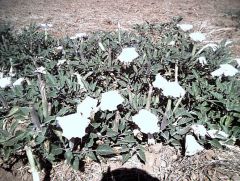
|
Datura is a light green annual or biennial shrubby plant that grows from two to five feet tall (one to three meters). It has hairy leaves, spiny fruit, and vibrant flowers. The best known species are D. stramonium (Jimson Weed), D. metel, and D. inoxia. The plants, seeds, flowers, and roots have all been traditionally used for medicinal or visionary purposes around the world. Dried leaves have been made into smoking blends, sometimes with in combination with tobacco or cannabis, and all parts have been used to make teas and ointments. Because datura is plentiful in many parts of the world, it is sometimes ingested for its psychoactive effects by those who are unaware that its effects may be dangerous and are generally considered very unpleasant. The main active chemicals present in datura are the tropane alkaloids scopolamine, atropine, and hyoscamine.
The main effects of datura are delirium, extreme disorientation, and realistic hallucinations. Many users report periods of several hours in which they have no memory of what they were doing. Behavior is often irrational and accidental injury is a serious risk. Datura also causes physical effects including blurred vision/inability to focus the eyes (lasting up to several days), dryness of mouth, sedation or excitement, inhibited digestion, and an inability to perspire. |
|
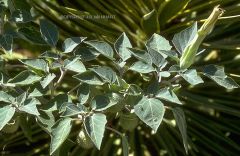
|
Datura is a light green annual or biennial shrubby plant that grows from two to five feet tall (one to three meters). It has hairy leaves, spiny fruit, and vibrant flowers. The best known species are D. stramonium (Jimson Weed), D. metel, and D. inoxia. The plants, seeds, flowers, and roots have all been traditionally used for medicinal or visionary purposes around the world. Dried leaves have been made into smoking blends, sometimes with in combination with tobacco or cannabis, and all parts have been used to make teas and ointments. Because datura is plentiful in many parts of the world, it is sometimes ingested for its psychoactive effects by those who are unaware that its effects may be dangerous and are generally considered very unpleasant. The main active chemicals present in datura are the tropane alkaloids scopolamine, atropine, and hyoscamine.
The main effects of datura are delirium, extreme disorientation, and realistic hallucinations. Many users report periods of several hours in which they have no memory of what they were doing. Behavior is often irrational and accidental injury is a serious risk. Datura also causes physical effects including blurred vision/inability to focus the eyes (lasting up to several days), dryness of mouth, sedation or excitement, inhibited digestion, and an inability to perspire. |
|
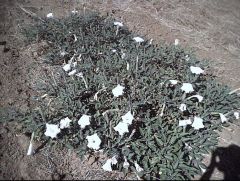
|
Datura is a light green annual or biennial shrubby plant that grows from two to five feet tall (one to three meters). It has hairy leaves, spiny fruit, and vibrant flowers. The best known species are D. stramonium (Jimson Weed), D. metel, and D. inoxia. The plants, seeds, flowers, and roots have all been traditionally used for medicinal or visionary purposes around the world. Dried leaves have been made into smoking blends, sometimes with in combination with tobacco or cannabis, and all parts have been used to make teas and ointments. Because datura is plentiful in many parts of the world, it is sometimes ingested for its psychoactive effects by those who are unaware that its effects may be dangerous and are generally considered very unpleasant. The main active chemicals present in datura are the tropane alkaloids scopolamine, atropine, and hyoscamine.
The main effects of datura are delirium, extreme disorientation, and realistic hallucinations. Many users report periods of several hours in which they have no memory of what they were doing. Behavior is often irrational and accidental injury is a serious risk. Datura also causes physical effects including blurred vision/inability to focus the eyes (lasting up to several days), dryness of mouth, sedation or excitement, inhibited digestion, and an inability to perspire. |
|
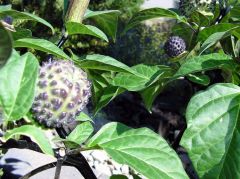
|
Datura is a light green annual or biennial shrubby plant that grows from two to five feet tall (one to three meters). It has hairy leaves, spiny fruit, and vibrant flowers. The best known species are D. stramonium (Jimson Weed), D. metel, and D. inoxia. The plants, seeds, flowers, and roots have all been traditionally used for medicinal or visionary purposes around the world. Dried leaves have been made into smoking blends, sometimes with in combination with tobacco or cannabis, and all parts have been used to make teas and ointments. Because datura is plentiful in many parts of the world, it is sometimes ingested for its psychoactive effects by those who are unaware that its effects may be dangerous and are generally considered very unpleasant. The main active chemicals present in datura are the tropane alkaloids scopolamine, atropine, and hyoscamine.
The main effects of datura are delirium, extreme disorientation, and realistic hallucinations. Many users report periods of several hours in which they have no memory of what they were doing. Behavior is often irrational and accidental injury is a serious risk. Datura also causes physical effects including blurred vision/inability to focus the eyes (lasting up to several days), dryness of mouth, sedation or excitement, inhibited digestion, and an inability to perspire. |
|
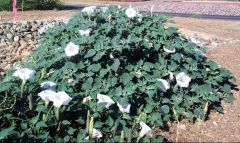
|
Datura is a light green annual or biennial shrubby plant that grows from two to five feet tall (one to three meters). It has hairy leaves, spiny fruit, and vibrant flowers. The best known species are D. stramonium (Jimson Weed), D. metel, and D. inoxia. The plants, seeds, flowers, and roots have all been traditionally used for medicinal or visionary purposes around the world. Dried leaves have been made into smoking blends, sometimes with in combination with tobacco or cannabis, and all parts have been used to make teas and ointments. Because datura is plentiful in many parts of the world, it is sometimes ingested for its psychoactive effects by those who are unaware that its effects may be dangerous and are generally considered very unpleasant. The main active chemicals present in datura are the tropane alkaloids scopolamine, atropine, and hyoscamine.
The main effects of datura are delirium, extreme disorientation, and realistic hallucinations. Many users report periods of several hours in which they have no memory of what they were doing. Behavior is often irrational and accidental injury is a serious risk. Datura also causes physical effects including blurred vision/inability to focus the eyes (lasting up to several days), dryness of mouth, sedation or excitement, inhibited digestion, and an inability to perspire. |
|
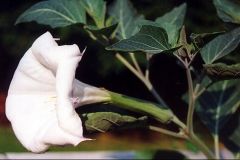
|
Datura is a light green annual or biennial shrubby plant that grows from two to five feet tall (one to three meters). It has hairy leaves, spiny fruit, and vibrant flowers. The best known species are D. stramonium (Jimson Weed), D. metel, and D. inoxia. The plants, seeds, flowers, and roots have all been traditionally used for medicinal or visionary purposes around the world. Dried leaves have been made into smoking blends, sometimes with in combination with tobacco or cannabis, and all parts have been used to make teas and ointments. Because datura is plentiful in many parts of the world, it is sometimes ingested for its psychoactive effects by those who are unaware that its effects may be dangerous and are generally considered very unpleasant. The main active chemicals present in datura are the tropane alkaloids scopolamine, atropine, and hyoscamine.
The main effects of datura are delirium, extreme disorientation, and realistic hallucinations. Many users report periods of several hours in which they have no memory of what they were doing. Behavior is often irrational and accidental injury is a serious risk. Datura also causes physical effects including blurred vision/inability to focus the eyes (lasting up to several days), dryness of mouth, sedation or excitement, inhibited digestion, and an inability to perspire. |
|
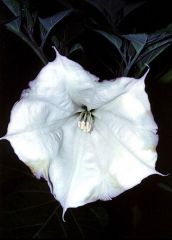
|
Datura is a light green annual or biennial shrubby plant that grows from two to five feet tall (one to three meters). It has hairy leaves, spiny fruit, and vibrant flowers. The best known species are D. stramonium (Jimson Weed), D. metel, and D. inoxia. The plants, seeds, flowers, and roots have all been traditionally used for medicinal or visionary purposes around the world. Dried leaves have been made into smoking blends, sometimes with in combination with tobacco or cannabis, and all parts have been used to make teas and ointments. Because datura is plentiful in many parts of the world, it is sometimes ingested for its psychoactive effects by those who are unaware that its effects may be dangerous and are generally considered very unpleasant. The main active chemicals present in datura are the tropane alkaloids scopolamine, atropine, and hyoscamine.
The main effects of datura are delirium, extreme disorientation, and realistic hallucinations. Many users report periods of several hours in which they have no memory of what they were doing. Behavior is often irrational and accidental injury is a serious risk. Datura also causes physical effects including blurred vision/inability to focus the eyes (lasting up to several days), dryness of mouth, sedation or excitement, inhibited digestion, and an inability to perspire. |
|
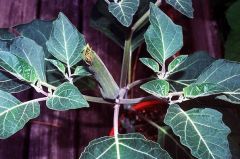
|
Datura is a light green annual or biennial shrubby plant that grows from two to five feet tall (one to three meters). It has hairy leaves, spiny fruit, and vibrant flowers. The best known species are D. stramonium (Jimson Weed), D. metel, and D. inoxia. The plants, seeds, flowers, and roots have all been traditionally used for medicinal or visionary purposes around the world. Dried leaves have been made into smoking blends, sometimes with in combination with tobacco or cannabis, and all parts have been used to make teas and ointments. Because datura is plentiful in many parts of the world, it is sometimes ingested for its psychoactive effects by those who are unaware that its effects may be dangerous and are generally considered very unpleasant. The main active chemicals present in datura are the tropane alkaloids scopolamine, atropine, and hyoscamine.
The main effects of datura are delirium, extreme disorientation, and realistic hallucinations. Many users report periods of several hours in which they have no memory of what they were doing. Behavior is often irrational and accidental injury is a serious risk. Datura also causes physical effects including blurred vision/inability to focus the eyes (lasting up to several days), dryness of mouth, sedation or excitement, inhibited digestion, and an inability to perspire. |
|
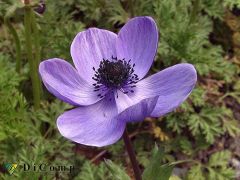
|
Anemone coronaria
|
|

|
Columbine (not Datura)
|
|
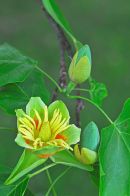
|
Liriodendron (not Datura)
|
|
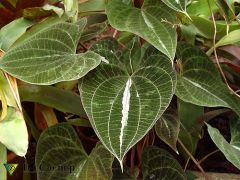
|
Dioscorea (not Datura)
|
|
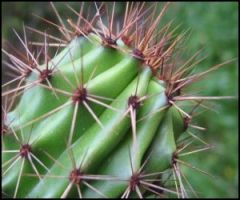
|
Cactus plant (not Datura)
|
|
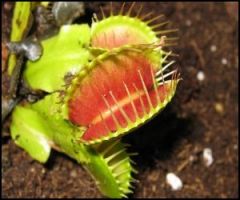
|
flytrap (not Datura)
|
|
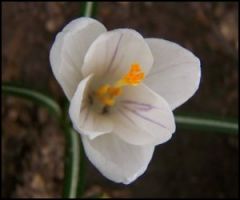
|
Crocus (not Datura)
|
|
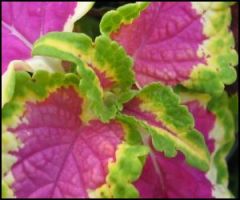
|
Coleus (not Datura)
|

